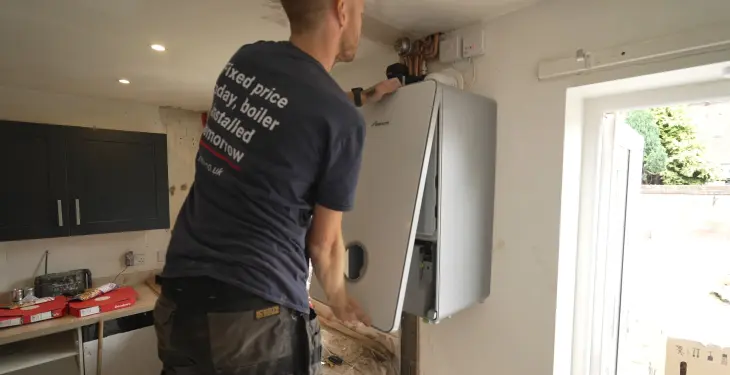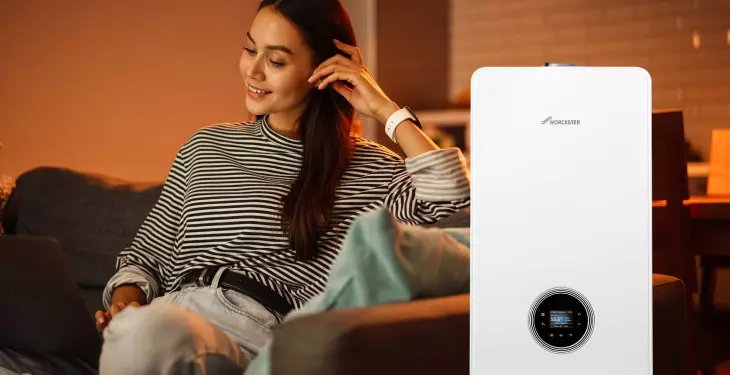

Written by Stephen Day
Gas Safe Engineer
Updated: 11th August, 2025
A boiler control panel is the interface that allows users to interact with their heating system. It enables individuals to adjust and manage the operational aspects of their boiler.
Get a new boiler quote, save up to £550 per year (0% APR available).
For many GB homeowners, understanding the boiler control panel can seem daunting, yet it is essential for a comfortable and energy-efficient home. The boiler control panel is the brain of your central heating system, managing everything from temperature settings to timings. By mastering the boiler control panel, you can significantly improve your home's energy conservation and reduce energy bills.
Setting up the control panel correctly involves knowing the various settings and functions. Modern boilers often include programmable thermostats, timers, and advanced features that respond to outdoor weather changes. Learning to navigate these options can ensure your heating system operates at peak efficiency, aligning with Boiler Plus legislation requirements.
Regular maintenance of your boiler control panel is crucial to keep it running. Checks and servicing can prevent unexpected breakdowns and extend the life of your boiler. Choosing the right boiler control panel for a home also plays a vital role in achieving optimal heating performance and compliance with regulations.
A boiler control panel is the interface that allows users to interact with their heating system. It enables individuals to adjust and manage the operational aspects of their boiler.
Key components usually include:
Thermostats: These devices let users set the desired temperature.
Timers: These help schedule when the heating should turn on and off.
The control panel often has:
Buttons or Dials: For changing settings.
Displays: Showing current temperature or system status.
Indicators: Such as a light to show if the system is on or has a fault.
By using the control panel, individuals can improve both the comfort and efficiency of their heating system.
Some panels also offer smart features like:
Remote Access: Where users can control the boiler via a smartphone app.
Energy-Saving Modes: To optimise energy usage.
Maintaining the right settings on the control panel is essential for both comfort and cost efficiency.
Boiler control panels allow users to manage heating and hot water systems efficiently. They include various components and features that help maintain desired temperature levels and energy efficiency.
There are several types of boiler control panels, each offering different functionalities:
Mechanical Controls: These are the most basic types and include simple dials and switches. They are easy to use but offer limited programming options.
Digital Controls: These panels provide more flexibility with programmable settings. Users can set specific times for heating and hot water.
Smart Controls: Integrated with smart home systems, these controls can be managed via smartphones or tablets. They offer remote access and advanced scheduling.
Choosing the right type of panel depends on the user's needs and the level of control desired.
Boiler control panels come with various components, each serving a specific function:
Thermostats: These detect and regulate the temperature. Room thermostats maintain the desired temperature by turning the heating on or off. Cylinder thermostats control the water temperature in the hot water tank.
Timers and Programmers: These allow users to set when the heating or hot water should turn on or off. This helps in conserving energy by only heating when necessary.
Sensors: These measure various parameters like temperature, pressure, and water levels, ensuring the boiler operates safely and efficiently.
Manual Controls: Often include buttons or dials for immediate adjustments, like resetting the system or changing temperature settings.
Each component works together to provide an efficient and user-friendly experience.
Boiler control panels play a crucial role in the efficiency of a heating system:
Energy Management: By accurately controlling the heating schedule and temperature, boiler controls reduce unnecessary energy consumption.
Optimised Performance: Sensors and thermostats ensure the boiler operates within the optimal range, preventing wear and tear and extending the boiler’s lifespan.
User Comfort: Programmable settings and remote access ensure a comfortable home environment without manual intervention.
Efficient control panels can lead to significant savings on energy bills and contribute to a more sustainable household.
Setting up a boiler control panel involves several important steps, including installation, navigating the control interface, and programming timers and thermostats. Each of these steps ensures your boiler is working efficiently and effectively to meet your heating needs.
The installation process begins with mounting the boiler control panel in a convenient location. Typically, it's installed near the boiler itself. It should be securely fastened to a wall or another sturdy surface.
Once mounted, connect the panel to the boiler using the appropriate wiring. This includes linking power supplies and control wires. Ensure all connections are tight and secure to prevent any electrical issues.
Next, turn on the power supply and check for any faults in the system. Follow the manufacturer's instructions to clear any error messages that appear. Once this is done, proceed to navigate the control interface.
The control interface may vary between different boiler models but generally includes a combination of buttons, dials, and digital displays. Digital interfaces often feature touch screens, while analogue systems may use knobs and switches.
Users should become familiar with the main controls, such as the power button, temperature settings, and system status indicators. These controls allow easy adjustments and monitoring of the boiler's performance.
Commonly, there will be an LCD display showing current settings and system statuses. Understanding the symbols and codes displayed on the screen is crucial for effective operation. Refer to the issue user manual to interpret these correctly.
Programming timers and thermostats is essential for optimising heating efficiency. Programmable timers allow users to set specific times for the boiler to operate, helping to save on energy costs.
To set a programmable timer, access the timer settings through the control panel. Input the desired on and off times for heating. Adjust these settings according to your daily routine to ensure comfort when needed.
For thermostat settings, either set the temperature using a dial (for analogue thermostats) or input the temperature digitally. Zonal thermostats can be programmed for different areas of the house, allowing for more precise control.
Ensure the thermostat is placed away from heat sources or draughts for accurate readings. Regularly check and adjust these settings for seasonal changes to maintain comfort and efficiency.
Advanced boiler control panels incorporate various features to improve energy efficiency and ease of use. Key elements include smart thermostats, load and weather compensation, and energy usage monitoring.
Smart thermostats are a modern feature in advanced boiler control panels. They automatically adjust heating settings based on user preferences and patterns.
These devices can be controlled using a smartphone or tablet through dedicated apps, providing remote access. Connectivity with other smart devices allows the thermostat to optimise energy use by adjusting to daily schedules.
Key Benefits:
Remote control via smartphone apps
Compatibility with other smart home devices
User-friendly interfaces for easy control
Load compensation adjusts the boiler's output based on the temperature inside the home. It ensures the boiler operates efficiently by reducing output as the room nears the desired temperature.
Weather compensation takes external temperatures into account, automatically adjusting the boiler settings. This feature improves energy efficiency by preventing overheating on warmer days and providing extra heat during colder periods.
Key Features:
Load compensation for internal temperature adjustments
Weather compensation for external temperature adjustments
Enhanced energy efficiency and comfort
Modern boiler control panels include energy usage monitoring. This feature helps users track their energy consumption and identify opportunities for savings.
By providing real-time data, homeowners can make informed decisions about their heating habits. Some systems also offer insights into how to improve energy efficiency.
Main Advantages:
Real-time energy usage data
Insights for reducing energy consumption
Improved energy management and cost savings
Effective heating efficiency and reducing energy bills can be achieved through smart temperature control, zoning your heating system, and ensuring proper insulation. These strategies can help balance comfort and cost savings.
Setting your boiler at the optimal temperature can significantly impact heating efficiency. Many experts recommend keeping the boiler at around 65°C. This is generally warm enough to provide a comfortable room temperature without wasting energy.
Modern thermostats, especially programmable and smart ones, allow precise temperature settings. They can be programmed to lower temperatures when no one is home or during the night. This reduces unnecessary heating and cuts down on heating bills.
Timers on your boiler can also help manage heating schedules effectively. Ensuring these devices are correctly set based on your routine can lead to significant cost savings.
Zoning your central heating system involves dividing your home into different areas or "zones" that can be heated independently. This can be done using thermostatic radiator valves (TRVs) and room thermostats.
Each zone can be controlled separately, so you only heat the rooms you are using. For instance, you might set a higher temperature in living areas during the day and a lower one in bedrooms.
Zoning helps in avoiding heating unused spaces, which can lead to significant savings on energy bills. It provides greater control and flexibility over your home’s heating, ensuring comfort where and when it is needed the most.
Proper insulation is essential for maintaining heating efficiency. Insulating your home reduces the amount of heat that escapes, keeping the indoor temperature steady with less energy.
Common areas to insulate include lofts, walls, and floors. Double glazing windows also play a critical role in retaining heat within your home.
Insulation not only helps in maintaining a consistent room temperature but also reduces the workload on your boiler. This leads to lower energy consumption and can significantly cut down on heating bills. Effective insulation solutions are a long-term investment that provide comfort and reduce heating costs.
Keeping the boiler control panel in great condition is crucial for homeowners and heating engineers. Regular inspections and quick troubleshooting can prevent major issues and ensure the system runs smoothly.
Regular inspection of the boiler control panel is necessary for optimal performance. Homeowners should check the panel every few months to ensure there are no visible signs of damage or wear. Look out for loose wires, burnt contacts, or any unusual noises coming from the panel.
Hiring a professional for an annual service is advisable. Heating engineers can conduct thorough inspections, checking the internal components that might not be visible to the untrained eye. They can also clean the panel and ensure that all parts are functioning correctly.
During the servicing, engineers will typically:
Test the electrical connections
Evaluate the thermostat
Check the control settings
By keeping a regular maintenance schedule, homeowners can extend the life of their boiler and avoid unexpected breakdowns.
When issues arise, it’s crucial to troubleshoot them efficiently. One common problem is the boiler not starting. This may be due to a tripped fuse or a power supply issue.
Check the display for error codes. These codes help identify whether the issue is with the thermostat, a sensor, or another component.
Thermostat problems are also frequent. If the thermostat isn’t responding, try resetting it or replacing the batteries. If it still doesn’t work, it might need a professional checkup.
Another issue is a frozen condensate pipe. This can especially occur during cold weather and may cause the boiler to shut down. Thawing the pipe safely can restore the boiler's function.
Proper troubleshooting can save time and ensure that small issues don’t become larger, more complicated problems.
Boiler Plus legislation, introduced by the Department for Business, Energy and Industrial Strategy (BEIS), aims to improve energy efficiency and reduce carbon footprints in homes across the UK. To comply with these regulations, it is crucial to understand the specific requirements and select suitable controls and thermostats.
Boiler Plus legislation was implemented to ensure domestic boilers meet high energy efficiency standards. All new gas boilers must have an energy-related products (ErP) efficiency of at least 92%. In addition to this, time and temperature controls are mandatory for all installations.
Moreover, the installation of new devices requires the inclusion of one of the following:
Load compensation controls
Weather compensation controls
Smart controls
These features contribute to better energy conservation, helping homeowners save on energy bills and reduce their environmental impact.
When choosing controls and thermostats, it's essential to ensure they meet Boiler Plus standards. Time and temperature controls are compulsory. Options for compliant devices include:
RTS Range
Digistat+2 or Digistat+3
Smart thermostats like the Wiser Multi-zone
For non-combi boilers, you must also fit appropriate time and temperature controls such as:
Digistat+/+RF
RTS range with SM1 / SM2
These controls not only comply with the legislation but also offer homeowners greater control over their heating systems. Selecting the right devices is paramount for energy conservation and lowering carbon emissions in accordance with Boiler Plus regulations.
Choosing the correct boiler control panel involves understanding your home's heating requirements, comparing different control options, and making a well-informed purchase decision. This ensures efficiency and comfort tailored to your needs.
First, assess your home’s specific heating requirements. Consider the size of your property, the number of radiators, and whether you have a hot water cylinder or a combi boiler. For larger homes with multiple radiators, thermostatic radiator valves (TRVs) help control the temperature in individual rooms.
Central heating controls are essential for managing heating costs and maintaining comfort. Homes with unique schedules may benefit from a programmer that allows for different heating times throughout the day. Additionally, if energy efficiency is a priority, consider condensing boilers paired with smart thermostats to adjust heating based on weather forecasts and occupancy patterns.
When comparing control panels, it’s important to look at features such as programmability, ease of use, and compatibility with existing systems.
There are several types of controls available, including:
Basic Programmers: Allow simple on/off scheduling for heating and hot water.
Room Thermostats: Maintain a constant temperature in a specific room.
Smart Thermostats: These offer advanced features like remote control via a smartphone app, learning your schedule, and adjusting settings automatically.
Thermostatic radiator valves are beneficial for controlling the temperature in individual rooms without manually adjusting each radiator. For those with a traditional setup, ensuring compatibility with your existing boiler, whether it’s a heat-only or combi boiler, is crucial.
Making the right purchase involves considering brand reputation, ease of installation, and support options. Researching customer reviews and professional recommendations can provide insight into reliability and user satisfaction.
Worcester Bosch, for example, is a well-regarded brand offering a range of compatible controls for both new and existing boilers. Look for panels that include a user-friendly interface and comprehensive instruction manuals. Energy savings and rebates may also be available when upgrading to a more efficient control system.
By considering these factors, you can select a control panel that balances comfort, efficiency, and cost, ensuring your home’s heating system meets your specific needs.
New boilers can be a daunting purchase for many people as they’re an appliance with a lot of responsibility, providing heat for you and your family is something you want to get right. Boilers aren’t exactly a quickly disposable item either, potentially lasting you a decade.
Effectively, new boiler cost can be split into two segments: the first is the actual boiler itself (unit price), and the second is the cost of the boiler being installed (set up) in your property by an expert engineer.
Here at iHeat, we remove all of this undue stress and make the decision making process of upgrading to a new heating system, as easy as possible.
New boiler costs can vary depending on a number of factors including their brand, model, fuel, output, warranty, labour and boiler installation type. Typically a new boiler will cost between £1,845 and £3,500, below is a list of average boiler installations offered by iHeat (guide only).
Installation Type | Price (inc VAT) | |
Combi to combi swap | £1,845 | |
System to combi conversion | £2,499 | |
New boiler install | £2,899 | |
Back boiler to a combi | £3,299 | |
System to system | £1,945 |
Last updated: 11th August, 2025

Written by Stephen Day
Gas Safe Engineer at iHeat
Stephen Day is a Gas Safe registered and FGAS certified engineer with over 20 years of hands-on experience in the heating, cooling, and renewable energy industry, specialising in boiler installations, air conditioning, and heat pump systems.
LinkedInArticles by Stephen Day are reviewed by iHeat’s technical team to ensure accuracy and reliability.

22nd December, 2025
Based on data from over 7000 boiler installations completed by iHeat in the past 12 months...
 Read Article
Read Article

22nd December, 2025
Here’s a quick roundup of the best combi boilers for 2026.
 Read Article
Read Article

22nd December, 2025
When your old boiler breaks down and it comes time to replace it with a new one, it might...
 Read Article
Read Article
No obligation. Takes less than 60 seconds.